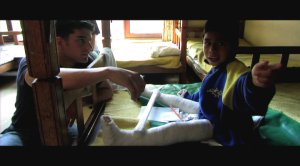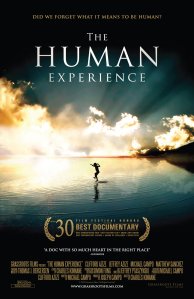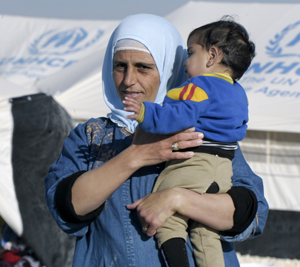Runtime: 90 minutes
Currently on Netflix: No
Currently on Indieflix: No
IMDb page: http://www.imdb.com/title/tt1252298/
Trailer: https://www.youtube.com/watch?v=ctyX5ItSQEI
For the first ever BSB documentary review I thought I’d write about one that is very special and dear to us: The Human Experience, a film about looking past any problems we as humans face because we are all going through this thing called “life” together.
Brothers Jeff and Cliff had an abusive past with an alcoholic father, and though they remember happy points throughout their childhood they seem to have missed out on the basic support system that a family is meant to provide. They live at the St. Francis House in Brooklyn, a men’s shelter meant to provide a structured haven of support, with their friends Matthew and Michael. They decide to film this documentary to answer the question, “where are we as humans going and why;” knowing that the only way to answer this question is to go out and actually visit people from various walks of life, they choose three lifestyles to follow: the homeless of New York City, a group of surfers who do international volunteer work, and the lepers of a colony in Ghana.
The two brothers have different feelings about spending several nights as a homeless person– several nights, I might add, that happened to be during a record-breaking cold stretch. Cliff is freezing, uncomfortable, and bored, whereas Jeff takes a more optimistic approach, looking at the cold as a sacrifice he’s willing to make to gain knowledge about this group of people. They interview several of New York’s homeless, who show them how to make shelter out of cardboard boxes and where the best places to sleep are.
Their second adventure takes them to Peru with a group called Surf for the Cause, a small group of surfers who seek out killer waves in poverty-stricken communities around the world. Jeff and Cliff worked at a clinic for children who are abandoned or who can not afford necessary medical treatments and, of course, quickly discovered which child was their favorite (reminiscent of our time in the day care centers in Mt. Vernon, even though they told us every year that we were not allowed to have “favorites”). Their big mission on this trip is to take the children to a larger hospital, and after a small car accident on the highway they manage to get them there safely. When thinking about the children facing unimaginable hardships, as well as his own abusive past, Jeff says, “it was the first time in a long time where I could feel peace in my heart.”

Finally, the brothers accompany Michael and Matthew to a leper colony in Ghana, arguably the ultimate image of a community of dispair and pain. The lepers, ostracized by their family and friends because of their culture’s belief that they are cursed, teach the boys that “even in the deepest suffering there is significance, there is a meaningful process of positive possibilities.” They then travel on to a community of people with AIDS where Michael, whose mother died of the disease when he was just nine years old, faces the fact that he never got to talk to her about it and overcomes this burden by realizing that though the people in this community are poor and a few short years from death, they are still happy because they have faith, friends and family.
The reason I love this documentary so much is because everyone can relate to it. Everyone has some sort of problem they are facing or trial that lies ahead; for me, that trial is moving 2300 miles from home to begin four grueling years in medical school while also joining the Air Force. My trial comes with a set of unique problems– doubting that I can make it through school, having to leave my family and girlfriend, wondering if I will fall victim to the depression and other stress-induced health problems associated with medical school– but even with these problems looming in the distance and getting closer by the second this film reminds me that I am not the only person in the world with problems. More importantly, however, it reminds me that everyone has their own path to take in life, and that these obstacles shouldn’t be seen as problems but rather as small bumps in the path that will make me stronger.
In examining my own problems I realize that I have it pretty well off compared to a lot of people in the world, and that if I have these relatively easy problems to deal with maybe I should help others who are facing problems far worse than mine (joining the military and becoming a doctor, though difficult, do not nearly compare to having leprosy and being shunned by my family and friends). After all, we’re all just floating on a big blue and green rock together— why not help one another out?
Prior to our own journey to live as immigrant farm workers, we watched several documentaries to determine the style that our own would take on. The Human Experience stuck with us for a long time, and we based the structure of our film off of it: one segment of our journey followed by a segment of interviews with experts (in the case of The Human Experience, these experts included an actor, scientist, artist, activist, traveler, advocate, crusader, cleric, priest, rabbi, and “philosopher king.”).
This documentary has won several national and international awards, and even though it was never a Sundance-sweeping blockbuster it is a film that I think everyone should watch at some point in their life, especially during a period of transition.
Cinematography: 7/10 Loved most of the camera shots, however the extreme close ups during interviews get old pretty quickly. I would have rather seen a mix of close and medium distance angles in these instances. But the shots of the landscape and travel were outstanding.
Soundtrack: 9/10 Excellent, moving music that fit well with the footage being shown.
Editing: 8/10 Ever since editing our film I have become more aware and nit-picky about editing mistakes, so there were a few parts that irked me; for example, in the middle of a conversation with several homeless in a soup kitchen the footage fades and a random quote appears on the screen, then the conversation resumes. However, the color and sound editing were very good, the overall footage sequence flowed pretty well, and I thought that having the interviews with the “experts” in black and white was a creative way to differentiate them from their journey.
Impact: 9/10 Like I said earlier, this is a great film to watch during a transition period in life because it encourages the viewer to step back and look at the big picture and realize that their problems are solvable.
Overall: 8.25/10. This is one of my favorites because the message is bigger than your job, race, creed, lifestyle or gender. No matter what life you lead, you can learn something from this movie.
Remember, we love discussion about movies! If you have an opinion about this film, or know of a documentary we should review, email us at bsberries@gmail.com or hit us up on Twitter or Facebook.
-Scott Hines
Scott Hines is a Director for Blood, Sweat and Berries.




